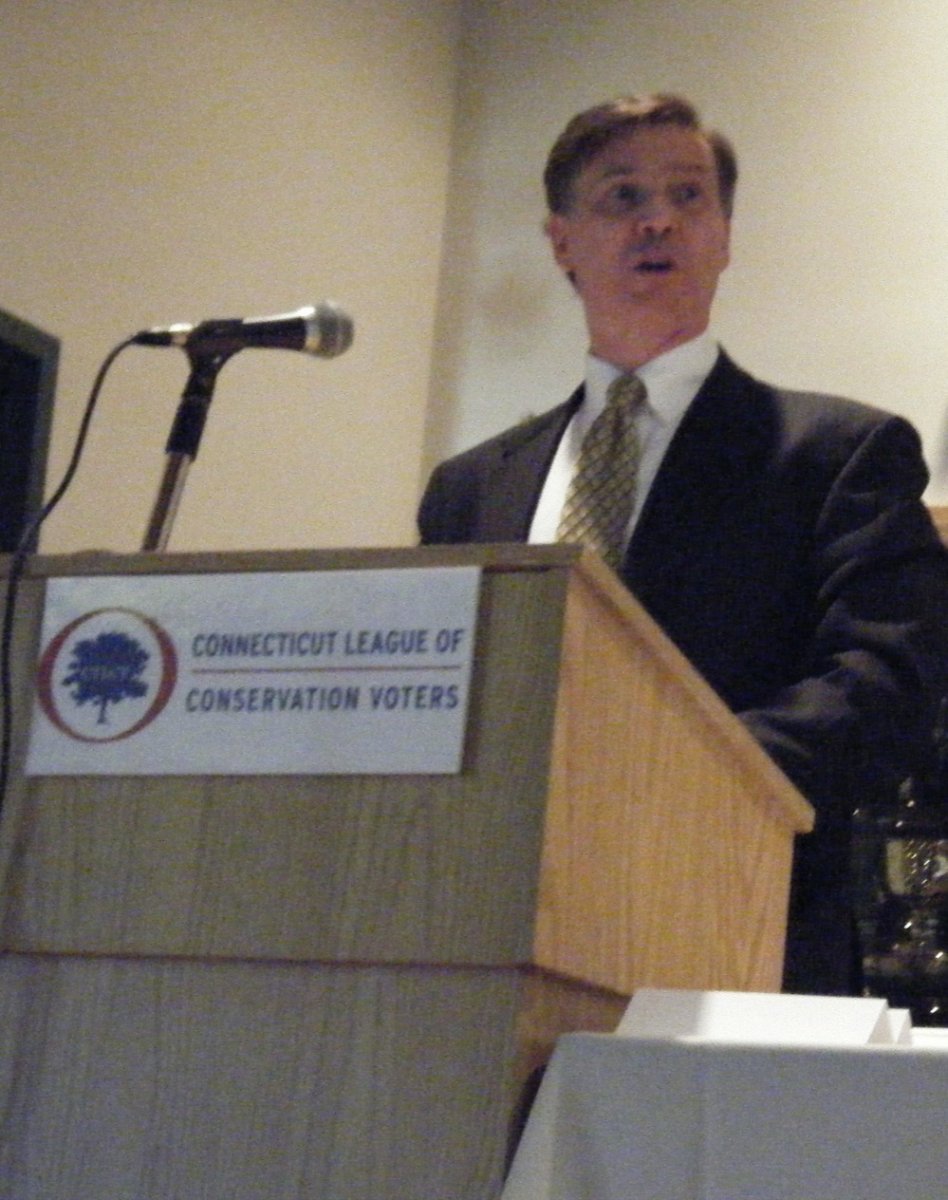On December 8, 2010, two months ahead of his appointment as Connecticut environmental commissioner, Dan Esty spoke about changing the economy to include renewables.
The Connecticut Mirror, March 7, 2011

It’s an alluring proposition: Connecticut solves its major energy problems while creating a new economy, cuts greenhouse gas emissions while building a new job base. People and the planet both win.
Gov. Dannel P. Malloy emphasized the green economy and creation of green jobs during his campaign, and named man who wrote the book on the subject-literally-as his environmental protection commissioner and chief energy advisor.
But experts agree that building a green economy will require major policy changes and lots of money. And there’s no clear course to follow.
“Future jobs? We don’t even know what those are today,” said Tom Burns, director of training at Northeast Utilities and chairman of the Connecticut Green Jobs Partnership. The partnership has $3.4 million in federal funds to help develop a green workforce, and it’s spreading the money widely to train, among others, sewage treatment managers, building inspectors and solar panel installers.
“I think one of the reasons the energy area is so dynamic is that the path to the future is quite unclear,” said Daniel C. Esty, a Yale law and environment school professor tapped by Malloy to take the lead on energy and environmental issues. “One thing policy has to do is to be robust.”
Malloy highlighted the intersection of energy, the environment and the economy when he proposed merging the state’s public utility authority into its environmental protection agency and named Esty to head the combined entity, to be called the Department of Energy and Environmental Protection. Esty has a national reputation for reconciling environmentalism and economic growth, and is the author of “Green to Gold: How Smart Companies Use Environmental Strategy to Innovate, Create Value, and Build Competitive Advantage.”
Energy is a key to Connecticut’s competitiveness as well: Electric rates here are the highest in the country, a fact frequently cited as a drag on the state’s business climate. Meanwhile, Connecticut is bound to its renewable energy pledge to produce 27 percent of its energy from renewable sources in only nine years; the state now is at about 4 percent.
Malloy has said that any policy to encourage renewable energy and efficiency must also be a jobs policy. Esty agrees, but he said it will be hard. Getting consumers to cut energy use is difficult, building a green economy will be costly, and there are many unknowns.
Changing the old model
Anyone squeamish about government investment in new energy technology need look no farther than across the Massachusetts border for an object lesson. In January, Evergreen Solar of Marlboro, Mass., known for cutting-edge solar panel technology, announced it would close its Devins factory, eliminating 800 jobs. The plant, which opened just 2½ years ago with some $58 million in state incentives, was a victim of cheaper Chinese products, company officials said.
But Connecticut can avoid such pitfalls by focusing on areas in which it already has an edge-things like designing energy-efficient building systems and products, said Matthew Nemerson, president and CEO of the Connecticut Technology Council.
“If I were to bet on anybody to create an industry that could speak to Connecticut strengths,” he said, “I would say that building environmental control systems might be a huge area we could lead the nation.”
United Technologies and others have been working on efficient building energy systems for a long time, Nemerson said, and that business is poised for growth.
“You don’t just throw out a building,” he said. “You retrofit buildings, you do better controls.”
Fear of failure and resistance to change, said University of Connecticut economics professor Fred Carstensen, will keep Connecticut from becoming the green economy equivalent of North Carolina’s Research Triangle, where Duke, North Carolina State, and the University of North Carolina attract industry with research and ideas.
To get there, he said, the old model of academic research and innovation– researchers get an idea, apply for grants and quietly toil in their labs for years–has to change. Policy-makers should be more engaged up front, helping set the research agenda.
Research Triangle succeeds, he said, because “You are not there for your own research. You are responding to your clients on an equal basis with pursuing your own research.”
As an example of meshing policy and research, Carstensen cites biofuels. For years, a few companies here tried to make and sell vegetable-based fuels for heating and driving diesel vehicles. The state’s classification of such fuels put it in the realm of waste and used tires, however, so the companies couldn’t get tax credits and the industry struggled.
UConn’s Center for Economic Analysis, which Carstensen heads, analyzed the health benefits of moving to biodiesel–less particulate air pollution. The presented their research to the General Assembly and eventually got a law passed that changed biofuels to a class I renewable energy source. The law also required increasing concentrations of biodiesel in home heating oil starting next year.
The lesson translates to many green industries, he says. Connecticut needs a cultural shift in how it thinks about emerging industries such as renewable fuels and technologies to use them.
“We need an institutional framework, funding, and a culture that says we’re going to develop the potential here,” Carstensen says.
Carstensen also said the state needs to develop new incentives and other policies to encourage development of high-tech industries. Last week the center issued a report saying Malloy’s budget plan was not bold enough to spur job growth.
Esty said the state is going to consider new approaches.
“We will need to look hard at the existing incentive structures. We have a lot of things encrusted into the law right now,” he said when he was appointed last month. “It’s just like the bottom of a ship where one barnacle goes on top of another. I think the governor is really committed to cleaning the hull.”
About This Article
This article was the overview in a continuing series of articles about how Connecticut’s economy could grow as the state saves energy and switches to renewable and efficient methods of making it. My editor is Michael Regan.
